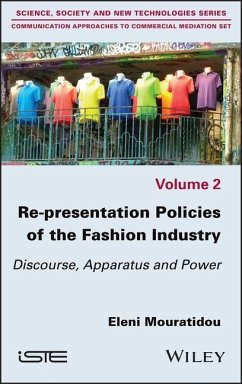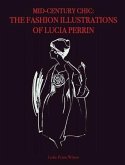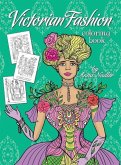- Gebundenes Buch
- Merkliste
- Auf die Merkliste
- Bewerten Bewerten
- Teilen
- Produkt teilen
- Produkterinnerung
- Produkterinnerung
The book studies the way the luxurious fashion develops re-presentational politics by reinvesting symbolic fields such as art and culture, religion and the sacred as well as politics, in other words fields that represent a certain common pattern of life and a common interest. I develop a semiotic approach of the way art exhibitions, print and audiovisual advertising, publishing and distribution politics as well as special ready to wear collaborations with arts such as Jeff Koons reveal the fashion industry�s gesture of pretending being a non-commercial structure especially in order to cover up its industrialisation and banalization process…mehr
Andere Kunden interessierten sich auch für
![A Collection of Interesting and Historic Prints: Being a Brief Presentation of Some of the Originals and Reproductions in the Possession of the State A Collection of Interesting and Historic Prints: Being a Brief Presentation of Some of the Originals and Reproductions in the Possession of the State]() A Collection of Interesting and Historic Prints: Being a Brief Presentation of Some of the Originals and Reproductions in the Possession of the State29,99 €
A Collection of Interesting and Historic Prints: Being a Brief Presentation of Some of the Originals and Reproductions in the Possession of the State29,99 €![Innovation in der Bauwirtschaft Innovation in the Building Industry Innovation in der Bauwirtschaft Innovation in the Building Industry]() Innovation in der Bauwirtschaft Innovation in the Building Industry99,95 €
Innovation in der Bauwirtschaft Innovation in the Building Industry99,95 €![Essays on Indian Art, Industry & Education Essays on Indian Art, Industry & Education]() Essays on Indian Art, Industry & Education35,99 €
Essays on Indian Art, Industry & Education35,99 €![Dyeing Elegance Dyeing Elegance]() Sonya Rhie QuintanillaDyeing Elegance28,99 €
Sonya Rhie QuintanillaDyeing Elegance28,99 €![Baluchars Baluchars]() Jasleen DhamijaBaluchars55,99 €
Jasleen DhamijaBaluchars55,99 €![Mid-Century Chic Mid-Century Chic]() Leslie Perrin WilsonMid-Century Chic32,99 €
Leslie Perrin WilsonMid-Century Chic32,99 €![Victorian Fashion Coloring Book Victorian Fashion Coloring Book]() Anna NadlerVictorian Fashion Coloring Book20,99 €
Anna NadlerVictorian Fashion Coloring Book20,99 €-
-
-
The book studies the way the luxurious fashion develops re-presentational politics by reinvesting symbolic fields such as art and culture, religion and the sacred as well as politics, in other words fields that represent a certain common pattern of life and a common interest. I develop a semiotic approach of the way art exhibitions, print and audiovisual advertising, publishing and distribution politics as well as special ready to wear collaborations with arts such as Jeff Koons reveal the fashion industry�s gesture of pretending being a non-commercial structure especially in order to cover up its industrialisation and banalization process
Hinweis: Dieser Artikel kann nur an eine deutsche Lieferadresse ausgeliefert werden.
Hinweis: Dieser Artikel kann nur an eine deutsche Lieferadresse ausgeliefert werden.
Produktdetails
- Produktdetails
- Verlag: Wiley
- Seitenzahl: 240
- Erscheinungstermin: 3. November 2020
- Englisch
- Abmessung: 234mm x 156mm x 14mm
- Gewicht: 513g
- ISBN-13: 9781786305916
- ISBN-10: 1786305917
- Artikelnr.: 60072370
- Herstellerkennzeichnung
- Libri GmbH
- Europaallee 1
- 36244 Bad Hersfeld
- gpsr@libri.de
- Verlag: Wiley
- Seitenzahl: 240
- Erscheinungstermin: 3. November 2020
- Englisch
- Abmessung: 234mm x 156mm x 14mm
- Gewicht: 513g
- ISBN-13: 9781786305916
- ISBN-10: 1786305917
- Artikelnr.: 60072370
- Herstellerkennzeichnung
- Libri GmbH
- Europaallee 1
- 36244 Bad Hersfeld
- gpsr@libri.de
Eleni Mouratidou: Lecturer in Media and Communication Studies, Paris 13 University - LabSic
Introduction ix
Part 1. Re-presentations and Artifices 1
Introduction to Part 1 3
Chapter 1. Re-presentation as a Form of Artistic and Cultural
Legitimization 5
1.1. The work of art and its reproducibility at the service of the fashion
industry 7
1.1.1. Culturization of the purse, and portability of the work of art 9
1.1.2. The purse as an apparatus for commercial and artistic mediation 12
1.2. Book publishing at the service of the fashion brand's cultural value
15
1.2.1. A book as beautiful as a trunk (Louis Vuitton) 16
1.2.2. Literary praise for luxury goods 19
1.3. The popularity of fashion accessories 20
1.3.1. The value of a luxury item through the club model 22
1.4. The exhibited advertising poster 24
1.4.1. Self-referential legitimations 25
1.4.2. Bricolage and illusion: advertising the advertising 27
1.5. The advertising poster as a testimonial discourse 29
1.5.1. The caption as a thematic and generic engagement 30
1.5.2. The presentation of the ready-to-wear collection as an event 32
Chapter 2. Investing Symbolically in the Museum, Transforming the Store:
Re-presentation as an Iterative Event 35
2.1. From the boutique to heritage enhancement sites 36
2.1.1. The place where the brand's heritage is developed: the advertiser's
dual entity 37
2.1.2. Patrimonialization and unadvertization: from forms to formats 40
2.2. The museum exhibition: a communicational pretext 42
2.2.1. Staging a symbolic distribution: from the discontinuous to the
continuous 43
2.2.2. The image of a work of art: symbolic distribution and artification
46
2.3. Distribution of marketable goods and contemporary art: the full and
the void 47
2.3.1. Cultural missions and department stores 48
2.3.2. From cultural mediations to market mediations (and vice versa) 49
2.3.3. In praise of the void and the worship of merchandise 53
Part 2. Re-presentations and Forms of Life: The Religious and the Political
57
Introduction to Part 2 59
Chapter 3. Re-presentation as a Cult Form 61
3.1. Biblical stories and media advertising: fashion and (divine) grace 64
3.1.1. Farmers, a storm and a boat: the biblical story of Noah's Ark 66
3.1.2. The Gucci actant: from ready-to-wear to ready-to-save 69
3.2. Biblical stories and media advertising: fashion and adoration 71
3.2.1. Advertising idolatry 73
3.2.2. From product name to brand signature 74
3.2.3. Actualization and ostentation of Dior's semiotic and religious
capital 76
3.3. From places dedicated to Christian worship to places dedicated to
fashion worship 78
3.3.1. From the Hospice des Incurables to the Balenciaga showroom 78
3.3.2. Profanation of the sacred, sacralisation of the lay public 82
3.3.3. Apparatus - Relic 84
3.3.4. Materiality, cult value and transparency 86
Chapter 4. Re-presentation as a Rewriting of Politics 89
4.1. The pretension of politics and its market value 93
4.1.1. Demonstration: presence, representation, event and spectacle 94
4.1.2. Re-presenting and misappropriating the demonstration 96
4.1.3. From stereotype to irony: political pretension 99
4.2. From text to (pre-)text: (political) mediations in the fashion
industry 100
4.2.1. Rewriting the media image: reintroducing the formula (to better
deconstruct it) 101
4.2.2. Imitation and counterfeiting of the event formula 104
4.3. Removal of the pre-text, and celebration of the pretext 108
4.3.1. Esthetization and commodification of the protest 108
4.3.2. Discrepancies between the medium and message 110
Part 3. The Power of the Fashion Industry's Re-presentational Apparatus
115
Introduction to Part 3 117
Chapter 5. The Industrialization of Creativity 119
5.1. From the aristocratic model to the market model: the industrialization
of luxury fashion 121
5.1.1. From the Court model to the designer model 121
5.1.2. From the market model to commercial luxury: pragmatic and symbolic
democratization 123
5.2. Managerial creativity as a panoply 126
5.2.1. Forms and powers of managerial creativity in the fashion industry
127
5.2.2. Standardization: the industrialization of managerial creativity 130
5.2.3. Semiotic management of managerial creativity in the face of the
market model 134
5.3. Physical space, media space and symbolic space 136
5.3.1. Material value and the immaterial value of fashion 138
5.3.2. Offshore manufacturing and production: a partial "made in France"
approach 140
5.3.3. Modes and cycles: an environmental problem 143
5.3.4. From the back to the front region: the fashion industry, the stage
and backstage 147
Chapter 6. Reinvesting, Diverting, Reformulating and Entertaining: The
Leisure-form of the Fashion Industry 153
6.1. Reinvestments and reintroductions: from appropriation to subversion
155
6.1.1 Investing, reinvesting, re-presenting, appropriating: legitimacy and
re-qualification 156
6.1.2. Reinvesting and subverting: the cultural hegemony of fashion 159
6.2. Diversions 162
6.2.1. Diverting politics 163
6.2.2. Diverting the diversion 165
6.3. Political power of the fashion industry's re-presentation apparatus
167
6.3.1. The media industry in question: a phantasmagoria 168
6.3.2. The leisure-form 171
Conclusion 175
References 181
Index 193
Part 1. Re-presentations and Artifices 1
Introduction to Part 1 3
Chapter 1. Re-presentation as a Form of Artistic and Cultural
Legitimization 5
1.1. The work of art and its reproducibility at the service of the fashion
industry 7
1.1.1. Culturization of the purse, and portability of the work of art 9
1.1.2. The purse as an apparatus for commercial and artistic mediation 12
1.2. Book publishing at the service of the fashion brand's cultural value
15
1.2.1. A book as beautiful as a trunk (Louis Vuitton) 16
1.2.2. Literary praise for luxury goods 19
1.3. The popularity of fashion accessories 20
1.3.1. The value of a luxury item through the club model 22
1.4. The exhibited advertising poster 24
1.4.1. Self-referential legitimations 25
1.4.2. Bricolage and illusion: advertising the advertising 27
1.5. The advertising poster as a testimonial discourse 29
1.5.1. The caption as a thematic and generic engagement 30
1.5.2. The presentation of the ready-to-wear collection as an event 32
Chapter 2. Investing Symbolically in the Museum, Transforming the Store:
Re-presentation as an Iterative Event 35
2.1. From the boutique to heritage enhancement sites 36
2.1.1. The place where the brand's heritage is developed: the advertiser's
dual entity 37
2.1.2. Patrimonialization and unadvertization: from forms to formats 40
2.2. The museum exhibition: a communicational pretext 42
2.2.1. Staging a symbolic distribution: from the discontinuous to the
continuous 43
2.2.2. The image of a work of art: symbolic distribution and artification
46
2.3. Distribution of marketable goods and contemporary art: the full and
the void 47
2.3.1. Cultural missions and department stores 48
2.3.2. From cultural mediations to market mediations (and vice versa) 49
2.3.3. In praise of the void and the worship of merchandise 53
Part 2. Re-presentations and Forms of Life: The Religious and the Political
57
Introduction to Part 2 59
Chapter 3. Re-presentation as a Cult Form 61
3.1. Biblical stories and media advertising: fashion and (divine) grace 64
3.1.1. Farmers, a storm and a boat: the biblical story of Noah's Ark 66
3.1.2. The Gucci actant: from ready-to-wear to ready-to-save 69
3.2. Biblical stories and media advertising: fashion and adoration 71
3.2.1. Advertising idolatry 73
3.2.2. From product name to brand signature 74
3.2.3. Actualization and ostentation of Dior's semiotic and religious
capital 76
3.3. From places dedicated to Christian worship to places dedicated to
fashion worship 78
3.3.1. From the Hospice des Incurables to the Balenciaga showroom 78
3.3.2. Profanation of the sacred, sacralisation of the lay public 82
3.3.3. Apparatus - Relic 84
3.3.4. Materiality, cult value and transparency 86
Chapter 4. Re-presentation as a Rewriting of Politics 89
4.1. The pretension of politics and its market value 93
4.1.1. Demonstration: presence, representation, event and spectacle 94
4.1.2. Re-presenting and misappropriating the demonstration 96
4.1.3. From stereotype to irony: political pretension 99
4.2. From text to (pre-)text: (political) mediations in the fashion
industry 100
4.2.1. Rewriting the media image: reintroducing the formula (to better
deconstruct it) 101
4.2.2. Imitation and counterfeiting of the event formula 104
4.3. Removal of the pre-text, and celebration of the pretext 108
4.3.1. Esthetization and commodification of the protest 108
4.3.2. Discrepancies between the medium and message 110
Part 3. The Power of the Fashion Industry's Re-presentational Apparatus
115
Introduction to Part 3 117
Chapter 5. The Industrialization of Creativity 119
5.1. From the aristocratic model to the market model: the industrialization
of luxury fashion 121
5.1.1. From the Court model to the designer model 121
5.1.2. From the market model to commercial luxury: pragmatic and symbolic
democratization 123
5.2. Managerial creativity as a panoply 126
5.2.1. Forms and powers of managerial creativity in the fashion industry
127
5.2.2. Standardization: the industrialization of managerial creativity 130
5.2.3. Semiotic management of managerial creativity in the face of the
market model 134
5.3. Physical space, media space and symbolic space 136
5.3.1. Material value and the immaterial value of fashion 138
5.3.2. Offshore manufacturing and production: a partial "made in France"
approach 140
5.3.3. Modes and cycles: an environmental problem 143
5.3.4. From the back to the front region: the fashion industry, the stage
and backstage 147
Chapter 6. Reinvesting, Diverting, Reformulating and Entertaining: The
Leisure-form of the Fashion Industry 153
6.1. Reinvestments and reintroductions: from appropriation to subversion
155
6.1.1 Investing, reinvesting, re-presenting, appropriating: legitimacy and
re-qualification 156
6.1.2. Reinvesting and subverting: the cultural hegemony of fashion 159
6.2. Diversions 162
6.2.1. Diverting politics 163
6.2.2. Diverting the diversion 165
6.3. Political power of the fashion industry's re-presentation apparatus
167
6.3.1. The media industry in question: a phantasmagoria 168
6.3.2. The leisure-form 171
Conclusion 175
References 181
Index 193
Introduction ix
Part 1. Re-presentations and Artifices 1
Introduction to Part 1 3
Chapter 1. Re-presentation as a Form of Artistic and Cultural
Legitimization 5
1.1. The work of art and its reproducibility at the service of the fashion
industry 7
1.1.1. Culturization of the purse, and portability of the work of art 9
1.1.2. The purse as an apparatus for commercial and artistic mediation 12
1.2. Book publishing at the service of the fashion brand's cultural value
15
1.2.1. A book as beautiful as a trunk (Louis Vuitton) 16
1.2.2. Literary praise for luxury goods 19
1.3. The popularity of fashion accessories 20
1.3.1. The value of a luxury item through the club model 22
1.4. The exhibited advertising poster 24
1.4.1. Self-referential legitimations 25
1.4.2. Bricolage and illusion: advertising the advertising 27
1.5. The advertising poster as a testimonial discourse 29
1.5.1. The caption as a thematic and generic engagement 30
1.5.2. The presentation of the ready-to-wear collection as an event 32
Chapter 2. Investing Symbolically in the Museum, Transforming the Store:
Re-presentation as an Iterative Event 35
2.1. From the boutique to heritage enhancement sites 36
2.1.1. The place where the brand's heritage is developed: the advertiser's
dual entity 37
2.1.2. Patrimonialization and unadvertization: from forms to formats 40
2.2. The museum exhibition: a communicational pretext 42
2.2.1. Staging a symbolic distribution: from the discontinuous to the
continuous 43
2.2.2. The image of a work of art: symbolic distribution and artification
46
2.3. Distribution of marketable goods and contemporary art: the full and
the void 47
2.3.1. Cultural missions and department stores 48
2.3.2. From cultural mediations to market mediations (and vice versa) 49
2.3.3. In praise of the void and the worship of merchandise 53
Part 2. Re-presentations and Forms of Life: The Religious and the Political
57
Introduction to Part 2 59
Chapter 3. Re-presentation as a Cult Form 61
3.1. Biblical stories and media advertising: fashion and (divine) grace 64
3.1.1. Farmers, a storm and a boat: the biblical story of Noah's Ark 66
3.1.2. The Gucci actant: from ready-to-wear to ready-to-save 69
3.2. Biblical stories and media advertising: fashion and adoration 71
3.2.1. Advertising idolatry 73
3.2.2. From product name to brand signature 74
3.2.3. Actualization and ostentation of Dior's semiotic and religious
capital 76
3.3. From places dedicated to Christian worship to places dedicated to
fashion worship 78
3.3.1. From the Hospice des Incurables to the Balenciaga showroom 78
3.3.2. Profanation of the sacred, sacralisation of the lay public 82
3.3.3. Apparatus - Relic 84
3.3.4. Materiality, cult value and transparency 86
Chapter 4. Re-presentation as a Rewriting of Politics 89
4.1. The pretension of politics and its market value 93
4.1.1. Demonstration: presence, representation, event and spectacle 94
4.1.2. Re-presenting and misappropriating the demonstration 96
4.1.3. From stereotype to irony: political pretension 99
4.2. From text to (pre-)text: (political) mediations in the fashion
industry 100
4.2.1. Rewriting the media image: reintroducing the formula (to better
deconstruct it) 101
4.2.2. Imitation and counterfeiting of the event formula 104
4.3. Removal of the pre-text, and celebration of the pretext 108
4.3.1. Esthetization and commodification of the protest 108
4.3.2. Discrepancies between the medium and message 110
Part 3. The Power of the Fashion Industry's Re-presentational Apparatus
115
Introduction to Part 3 117
Chapter 5. The Industrialization of Creativity 119
5.1. From the aristocratic model to the market model: the industrialization
of luxury fashion 121
5.1.1. From the Court model to the designer model 121
5.1.2. From the market model to commercial luxury: pragmatic and symbolic
democratization 123
5.2. Managerial creativity as a panoply 126
5.2.1. Forms and powers of managerial creativity in the fashion industry
127
5.2.2. Standardization: the industrialization of managerial creativity 130
5.2.3. Semiotic management of managerial creativity in the face of the
market model 134
5.3. Physical space, media space and symbolic space 136
5.3.1. Material value and the immaterial value of fashion 138
5.3.2. Offshore manufacturing and production: a partial "made in France"
approach 140
5.3.3. Modes and cycles: an environmental problem 143
5.3.4. From the back to the front region: the fashion industry, the stage
and backstage 147
Chapter 6. Reinvesting, Diverting, Reformulating and Entertaining: The
Leisure-form of the Fashion Industry 153
6.1. Reinvestments and reintroductions: from appropriation to subversion
155
6.1.1 Investing, reinvesting, re-presenting, appropriating: legitimacy and
re-qualification 156
6.1.2. Reinvesting and subverting: the cultural hegemony of fashion 159
6.2. Diversions 162
6.2.1. Diverting politics 163
6.2.2. Diverting the diversion 165
6.3. Political power of the fashion industry's re-presentation apparatus
167
6.3.1. The media industry in question: a phantasmagoria 168
6.3.2. The leisure-form 171
Conclusion 175
References 181
Index 193
Part 1. Re-presentations and Artifices 1
Introduction to Part 1 3
Chapter 1. Re-presentation as a Form of Artistic and Cultural
Legitimization 5
1.1. The work of art and its reproducibility at the service of the fashion
industry 7
1.1.1. Culturization of the purse, and portability of the work of art 9
1.1.2. The purse as an apparatus for commercial and artistic mediation 12
1.2. Book publishing at the service of the fashion brand's cultural value
15
1.2.1. A book as beautiful as a trunk (Louis Vuitton) 16
1.2.2. Literary praise for luxury goods 19
1.3. The popularity of fashion accessories 20
1.3.1. The value of a luxury item through the club model 22
1.4. The exhibited advertising poster 24
1.4.1. Self-referential legitimations 25
1.4.2. Bricolage and illusion: advertising the advertising 27
1.5. The advertising poster as a testimonial discourse 29
1.5.1. The caption as a thematic and generic engagement 30
1.5.2. The presentation of the ready-to-wear collection as an event 32
Chapter 2. Investing Symbolically in the Museum, Transforming the Store:
Re-presentation as an Iterative Event 35
2.1. From the boutique to heritage enhancement sites 36
2.1.1. The place where the brand's heritage is developed: the advertiser's
dual entity 37
2.1.2. Patrimonialization and unadvertization: from forms to formats 40
2.2. The museum exhibition: a communicational pretext 42
2.2.1. Staging a symbolic distribution: from the discontinuous to the
continuous 43
2.2.2. The image of a work of art: symbolic distribution and artification
46
2.3. Distribution of marketable goods and contemporary art: the full and
the void 47
2.3.1. Cultural missions and department stores 48
2.3.2. From cultural mediations to market mediations (and vice versa) 49
2.3.3. In praise of the void and the worship of merchandise 53
Part 2. Re-presentations and Forms of Life: The Religious and the Political
57
Introduction to Part 2 59
Chapter 3. Re-presentation as a Cult Form 61
3.1. Biblical stories and media advertising: fashion and (divine) grace 64
3.1.1. Farmers, a storm and a boat: the biblical story of Noah's Ark 66
3.1.2. The Gucci actant: from ready-to-wear to ready-to-save 69
3.2. Biblical stories and media advertising: fashion and adoration 71
3.2.1. Advertising idolatry 73
3.2.2. From product name to brand signature 74
3.2.3. Actualization and ostentation of Dior's semiotic and religious
capital 76
3.3. From places dedicated to Christian worship to places dedicated to
fashion worship 78
3.3.1. From the Hospice des Incurables to the Balenciaga showroom 78
3.3.2. Profanation of the sacred, sacralisation of the lay public 82
3.3.3. Apparatus - Relic 84
3.3.4. Materiality, cult value and transparency 86
Chapter 4. Re-presentation as a Rewriting of Politics 89
4.1. The pretension of politics and its market value 93
4.1.1. Demonstration: presence, representation, event and spectacle 94
4.1.2. Re-presenting and misappropriating the demonstration 96
4.1.3. From stereotype to irony: political pretension 99
4.2. From text to (pre-)text: (political) mediations in the fashion
industry 100
4.2.1. Rewriting the media image: reintroducing the formula (to better
deconstruct it) 101
4.2.2. Imitation and counterfeiting of the event formula 104
4.3. Removal of the pre-text, and celebration of the pretext 108
4.3.1. Esthetization and commodification of the protest 108
4.3.2. Discrepancies between the medium and message 110
Part 3. The Power of the Fashion Industry's Re-presentational Apparatus
115
Introduction to Part 3 117
Chapter 5. The Industrialization of Creativity 119
5.1. From the aristocratic model to the market model: the industrialization
of luxury fashion 121
5.1.1. From the Court model to the designer model 121
5.1.2. From the market model to commercial luxury: pragmatic and symbolic
democratization 123
5.2. Managerial creativity as a panoply 126
5.2.1. Forms and powers of managerial creativity in the fashion industry
127
5.2.2. Standardization: the industrialization of managerial creativity 130
5.2.3. Semiotic management of managerial creativity in the face of the
market model 134
5.3. Physical space, media space and symbolic space 136
5.3.1. Material value and the immaterial value of fashion 138
5.3.2. Offshore manufacturing and production: a partial "made in France"
approach 140
5.3.3. Modes and cycles: an environmental problem 143
5.3.4. From the back to the front region: the fashion industry, the stage
and backstage 147
Chapter 6. Reinvesting, Diverting, Reformulating and Entertaining: The
Leisure-form of the Fashion Industry 153
6.1. Reinvestments and reintroductions: from appropriation to subversion
155
6.1.1 Investing, reinvesting, re-presenting, appropriating: legitimacy and
re-qualification 156
6.1.2. Reinvesting and subverting: the cultural hegemony of fashion 159
6.2. Diversions 162
6.2.1. Diverting politics 163
6.2.2. Diverting the diversion 165
6.3. Political power of the fashion industry's re-presentation apparatus
167
6.3.1. The media industry in question: a phantasmagoria 168
6.3.2. The leisure-form 171
Conclusion 175
References 181
Index 193








